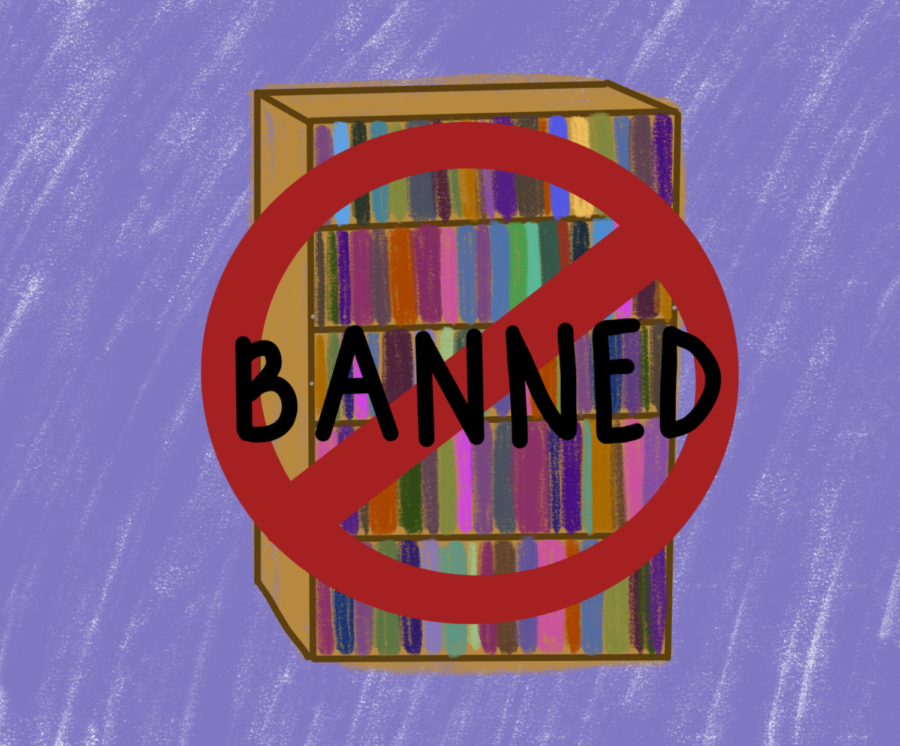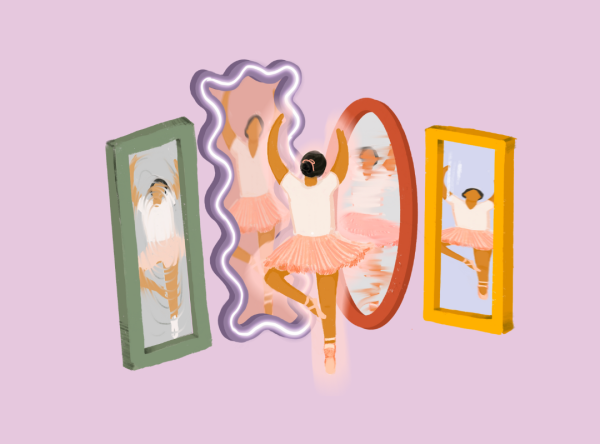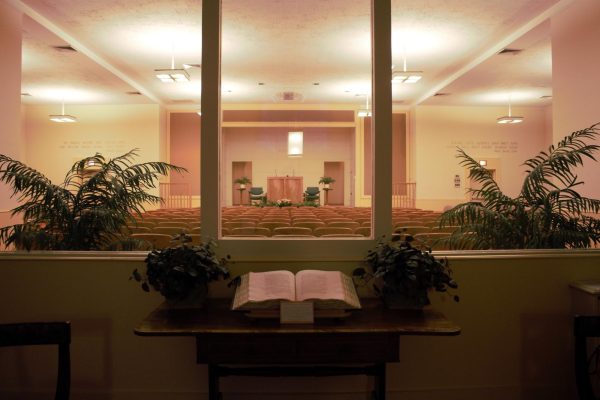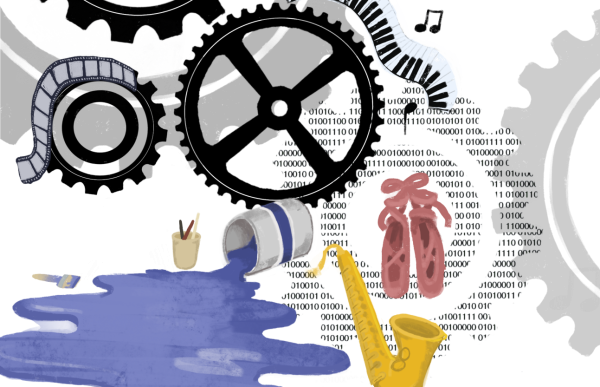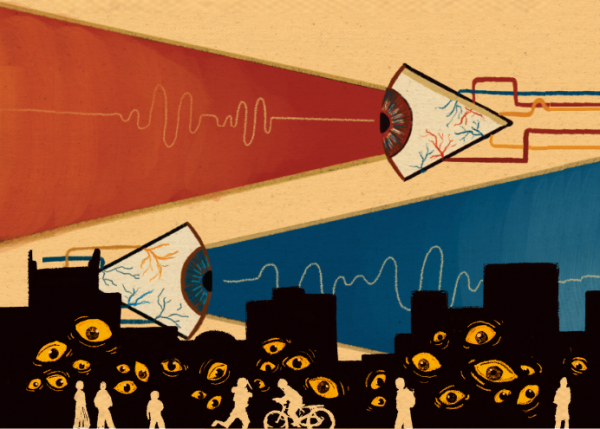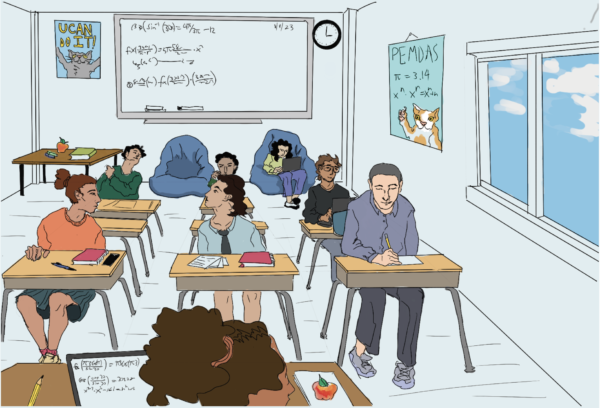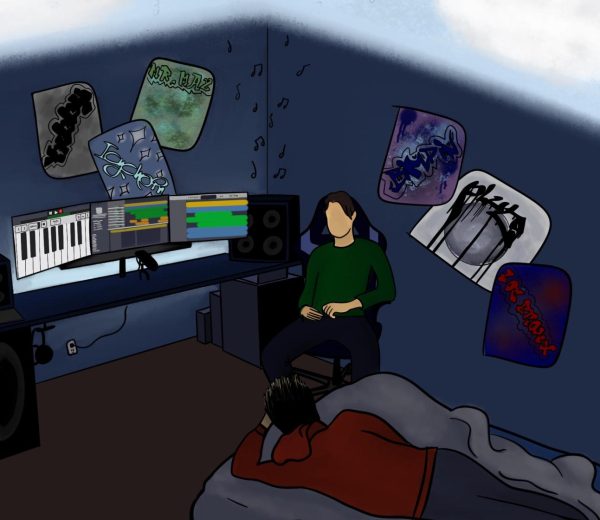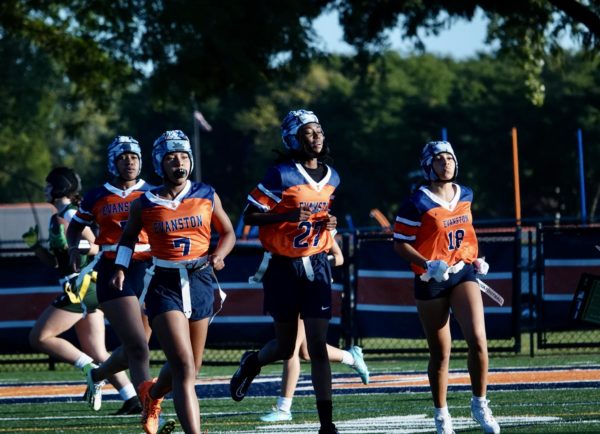Banished and embellished: an analysis of appropriate content in high schools
It is undeniable that schools are formative places for young people. The lessons taught within academic institutions leave a mark on students at their most impressionable ages. There is a gravity in the responsibility to accurately, effectively and respectfully teach students about complex and sensitive issues such as racism, violence and abuse.
Superintendent Dr. Eric Witherspoon comments on the onus schools such as ETHS have in fostering an environment where student wellbeing is prioritized.
“What we need to always do is just be so careful that we are creating the safest environment [at ETHS] and communicating, so people can feel safe in their own school because safety is fundamental to the human experience. Safety is fundamental to our ability to be more self-actualized, … It’s so interesting, because certainly there could be something really big happening that’s triggering for a lot of people, but, usually, different people respond to different stimuli in different ways.”
While physical and emotional safety is crucial to creating a strong school community, ETHS also does not want to shy away from addressing sensitive topics or censoring what is taught.
Nationally, discussions around censorship in schools have reappeared, raising questions and debates surrounding the intention, purpose and usefulness of exposing students to critical, challenging and possibly triggering content.
For instance, books have been recently challenged and banned at an increasing rate from schools and other institutions across the nation. Books can be “challenged” when a person or group sends in a complaint and asserts that a certain book(s) should be removed from schools or libraries. The American Library Association (ALA) has reported that from September to December of 2021, 330 challenges were issued against books, and due to unreported cases of complaints, the true number may be higher.
Book banning can be used to discriminate against groups such as people of color and members of the LGBTQ+ community, attempting to hide their stories, struggles and accomplishments, and a large part of books being currently banned are ones that discuss gender, race, sex and sexuality. The ALA lists its ten most challenged books from 2020. All of them discuss these topics. Groups have formed to push to ban critical race theory and LGBTQ+ learning materials from public schools. In Oklahoma, the Senate advanced a bill that would ban books addressing sex and sexual and gender identities from school. In Tennessee, McMinn County’s Board of Education banned Maus, a graphic novel that addresses the Holocaust, from its eighth-grade curriculum citing that the reasons for the ban are swearing and scenes of nudity.
Instances such as these have faced stark opposition and a loud outcry of anger from students, educators and the public.
Much of this struggle can be attributed to arguments over the appropriateness of certain materials in public education, the responsibilities of schools to educate and the impetus on academic institutions to provide a safe environment to their students. Some people believe that books should not be taught in school that do not reflect the values or beliefs of the children’s families or that some books or other learning materials are too sensitive to be addressed in school. Many books and other materials contain graphic descriptions of sexual assault, racism and violence that can greatly disturb students. Others argue that this is censorship and is wrong, as schools are supposed to be a center of learning. People with that perspective believe restricting what materials children can see restricts their education and growth; a student shouldn’t be kept from learning something because their parents or other adults don’t agree with the materials it presents.
In this article, we will discuss the topics of censorship and the appropriateness of sensitive materials and reflect on ETHS teacher and student experiences and thoughts on these topics. We will reflect on the responsibility of schools to cover sensitive issues and the limits the schools have, if any, on exposing students to difficult subject matters.
Sensitive Content at ETHS
With over 250 courses provided and over 250 teachers employed, ETHS’ classroom material takes many different forms. Although factors such as state laws and board rulings may set the foundation for ETHS curricula, teachers ultimately decide their personal approach to teaching their designated course, which allows for each individual classroom to absorb content uniquely. Due to the nature of high school curricula, various courses include sensitive material that have the potential to evoke strong emotions in students, and it is teachers that must decide how they choose to teach these difficult topics.
Educator and author of Equity-Centered Trauma Informed Education Alex Shevrin Venet speaks on how she believes teachers should navigate their sensitive lessons. She outlines three key components every teacher should prioritize: transparency, choice and support.
“Transparency [is] about letting students know [by saying], ‘Here’s what we’re going to be talking about, [and] this might be stressful for some people. If you’re feeling like you are having a hard time with this topic, here’s the resources for you,’” Venet explains. “Basically, just being upfront with students so that you’re not shocking them.”
Venet highlights a practice that has become increasingly standard amongst classroom environments: the usage of trigger warnings. Merriam-Webster defines trigger warning as, “a statement cautioning that content (as in a text, video, or class) may be disturbing or upsetting.” Although trigger warnings have become more ubiquitous in recent years, students describe that their experiences with teachers still vary in terms of receiving this upfront notice.
“I’ve had teachers who have been very aware of the content they’re showing the class, and then I’ve met teachers that haven’t [been]; I think it’s really dependent upon the [teacher] themselves,” junior Eleanor Jones shares. “I’m speaking from my own experience, and I know students tend to appreciate when teachers [implement trigger warnings], regardless of whether or not [the individual student] needs the warning. It’s nice to prepare yourself for any sort of violent or uncomfortable content, regardless of whether or not it seriously counts as a trigger for you.”
In addition to the implementation of trigger warnings varying across different classrooms, trauma and triggers vary across students. Students have expressed that given the variation of trauma and triggers throughout the student body, distinct components of curriculum may resonate with students in different ways, and, Venet argues, it is not the responsibility of the teacher to determine why.
“Another thing I’d say to teachers is that a teacher shouldn’t be a trauma detective, and what I mean by that is that it’s not the teacher’s job to know exactly what’s going on in each student’s life in regards to their previous trauma,” Venet explains. “For example, you’re reading a book, it has a scene with sexual assault, and the student needs a different option. The teacher should make an environment where the student can just say, ‘I need a different option for this test,’ and the teacher shouldn’t say, ‘Why do you need it? You have to justify that to me; tell me why this is triggering to you.’”
Although the teacher should not require the context as to why specific material may be triggering to students, it is important to acknowledge that teachers may not always know that the content is triggering at all. In this instance, teachers must rely on student feedback in a noninvasive way.
AP Language and Composition (AP Lang) teacher Mara Neill explains her approach to teaching The Bluest Eye, a novel written by Toni Morrison that contains graphic recounts of sexual violence. Neill shares that before she instructs students to read the text, she provides an extensive list of trigger warnings, which has been revised through student advocacy over the past 10 years in which Neill has taught the book.
“When I started teaching [The Bluest Eye], I didn’t have as many trigger warning pages, and I didn’t call them trigger warning pages—that wasn’t a term,” Neill discloses. “Then some students were like, ‘You should add this [as a trigger warning],’ which is fine, and I appreciate that. There are definitely things that change [according to student feedback].”
While trigger warnings can serve as useful tools to prepare students for heavier content, they cannot work in isolation. When students are provided with advanced notice of sensitive material, some may decide it is in their best interest to withdraw themselves from exposure to this content. This demonstrates Venet’s second essential factor of teaching sensitive topics: choice.
“The second thing I said was autonomy or choice, and that’s basically the idea that you give students control and options. The idea isn’t that you’re putting bubble wrap around kids; you don’t want to not teach something because it’s hard, but instead, you give people options of how to engage,” Venet shares.
In the effort to prioritize student choice, many teachers have adopted plans for alternate lessons or materials during sensitive units.
In regards to teaching The Bluest Eye, Neill explains, “I always tell students that they can read a different book. If they’re not comfortable with this, there’s another book we can read, and you can do the same activities and write the same type of essay.”
However, there is some content that some believe must be absorbed by students, even though it may be uncomfortable. At ETHS, Narrative of the Life of Frederick Douglass is a required text for all junior English classes. The autobiography includes vivid description of slavery, which is largely difficult for the audience to take in. Nonetheless, many believe that it is still essential to read and understand this material, due to its historical significance. Neill explains how she requires students to read the book, but she allows some choice in the level at which students participate with the text.
Neill prefaces that in addition to discussing sensitive language in her class prior to introducing Douglass’ narrative, “We also talk about the sensitive scenes of Frederick Douglass, and we talk about how to approach them. [We establish] that it’s important, because it’s nonfiction, that we read those graphic scenes, because this is true and this happened, and we don’t want to whitewash that … Then I talk about the different pages where there are going to be sensitive topics and [the] various ways that we can approach those. [For example], skimming through [scenes, because] you don’t need to read every single word of a passage that is triggering.”
In essence, Neill highlights the importance of incorporating certain uncomfortable topics into classroom atmospheres without overwhelming the emotional needs of students. Venet reinforces this notion.
“I think a lot of people, when they think about trauma, they don’t recognize the connection between healthy stress and when that crosses over into being traumatic,” Venet says. “I think when people have had life experiences where they haven’t really had to cross over that line, they just don’t quite understand what it feels like.”
While it is important to introduce sensitive content in a way that doesn’t extend into unnecessarily triggering material, finding the boundary between the two can sometimes become a difficult task.
“I think it’s a delicate balance, because you don’t want to overload students, but you want them to understand what really happened. That’s the point of history: for them to understand the past,” shares junior Keira Tu, recalling her experience in her history classes. “I think, in a lot of cases, what you’re trying to get students to take away from slavery units is that it was horrific, and maybe you don’t need to show them [visual] scenes of people getting whipped or beaten or killed, but [students] should still understand what happened.”
Tu expresses the choice teachers may have in selecting the material they present in class. However, many teachers will still show graphic videos, images, texts and other content. In these cases, students are often provided with the choice to disengage.
Forensics teacher Andrew Held discusses how he implements choice into the sensitive nature of the subject he teaches. “Anytime [there’s] going to be a crime scene photo, or [in] our sexual assault units, I do give trigger warnings and give kids the opportunity to step out, go to the Hub [student center], get out of the classroom and have an alternative assignment. Some students take advantage of it, a few every year, so that’s how I handle it.”
Although teachers frequently provide students with the choice to leave the classroom, students share that they don’t always feel comfortable in doing so. Freshman Elijah Hamann recounts his experience when given the opportunity to leave during a sensitive school assembly. He notes that the speaker gave the audience a trigger warning, but the tone in which it was delivered added a sense of pressure to stay in the assembly and engage with the content.
“[The speaker] said [something] like, ‘If you leave, you’re a wimp’ … That defeats the whole purpose of a trigger warning.”
In addition to feeling pressure from authority figures to remain engaged with upsetting material, students express a sense of discomfort in leaving the classroom in front of their peers.
“I think it’s good to have students step out if they need to, but I feel like it’s kind of awkward [to] … I’ve never seen anyone actually go out of the classroom,” freshman Talia Wisely shares.
Wisely believes that allowing students to leave the classroom can be productive while also providing the opportunity for students to make that decision in a more private environment.
“I think it’s more appropriate to be able to talk to someone one-on-one if you’re specifically struggling or if something is specifically triggering you,” Wisely explains. “Students should be able to talk to their teachers [separately] if they’re really uncomfortable with [the content], and it doesn’t have to be announced to the class.”
In addition to allowing students to decide their level of exposure to various elements of the curriculum, providing classes with choice in elements of the course can also help teachers create an atmosphere that prioritizes student wellbeing.
“We had the option to have a police officer come in this year, and one of the bits of feedback I got was, ‘Can we have at least a conversation before you uniformly decide to bring a cop?’” Held describes. “This year, I gave a survey and in the survey, the majority [said] ‘No, we don’t necessarily need to hear from a cop,’ so I told the police officer, ‘No, you don’t need to come in,’ and he was okay with it. I gave the kids that power, and they decided and said no.”
While some students may choose to separate themselves from the content that upsets them, others may prefer to absorb the given material as the teacher intends. When students fully engage with the curriculum, they may require some additional resources to meet their emotional needs. Venet explains how teachers can ensure that students are well-supported throughout the course.
“Support is the third thing, so [teachers should avoid] dropping heavy topics and then [offering no follow-up]. [Teachers can be] providing resources, collaborating with the counselor, letting students journal or process their emotions about it and just making sure [students] have the opportunity that if they’re having a hard time, they don’t have to go process by themselves,” Venet elaborates.
Assistant Superintendent and Principal Marcus Campbell emphasizes the significance of providing support throughout upsetting curriculum.
“[Approaching sensitive content] takes a lot of intentionality, care and support. We often send guidance to teachers if they’re going to be talking about sensitive subjects,” Campbell shares.
He goes on to offer his own opinion on how he believes teachers should monitor these heavy topics.
“I think that whoever’s leading the conversation [whether that be a] classroom conversation [or] an extracurricular conversation … has to prepare students [and] has to have some structures of support in place for students. To fail to do that is instructional malpractice.”
Superintendent Eric Witherspoon expands on these systems of support, noting the school resources students have available to them.
“One of the things that I think that we really need to do is have good counseling with social workers [and have] adults in the building who are aware and responsive and will follow up with students.”
Witherspoon highlights the significance of offering support to students as they navigate this difficult material. In doing so, it is vital to understand how individual experiences shape students’ capacity to handle different content.
“The one thing that we learn more and more in our own experiences is that every human being is different, and every human being will handle whatever the topic or whatever the situation is differently,” Witherspoon concludes. “Whilst for one person, it might really stir a lot of emotion and difficulty, for the next person, they [might] just let it roll off. What matters is that … the discussions feel as safe as possible for the people who are involved in them.”
Student Response
At ETHS, almost no topic is left untouched. Whether it be in classrooms, through infographics taped onto bathroom walls, or in our 62 clubs and activities, students are constantly engaging with historical content. By the time freshmen acclimate to campus, they will have already learned about ancient civilizations, global history, social movements of the 60’s and American institutions in their Humanities classes—all of which will be re-addressed during their upperclassmen years. Our educational experiences fundamentally mold the way we engage with the world, but educators’ freedom in teaching content presents potential implications for students.
“[This year,] my English teacher made [my class read a short-story] and just didn’t tell us that the main character kills himself at the end. It wasn’t that detailed, but it would’ve been nice to [have been given a warning],” recalls Jones.
When asked about another instance in which her teacher failed to provide a trigger warning, Jones replied, “[In] Biology freshman year, my teacher had us watch Gatica. At the end of the movie, one of the main characters throws himself in an incinerator. [My teacher] didn’t [warn] us about this, and at the time, I had just gone through a serious depressive episode.”
Mental health is a vital consideration that is frequently missing in classroom discussions. Without acknowledging students’ relationship with mental illness, teachers can unintentionally trigger students and prevent them from engaging in class.
Venet explains how mental illness and curricula function in tandem. “When a person is so stressed [by the content they absorb], they get flooded with [this] survival instinct: fight [or] flight. [From this reaction], you freeze and your body floods with chemicals. [Students] can’t actually learn if they feel like that,” she says.
Triggering content, as described by Venet, can have long, unintended consequences for students and teachers alike. Of course, there is no uniform explanation to students’ reaction to triggering content. Trauma and mental health are intrinsically multifaceted and affect each individual differently. To make sense of students’ responsive variation, Venet explains that often one’s reaction is influenced by one major component: identity.
“Based on your identity, some content is going to feel very personal. For example, I’m Jewish, and when I learned about the Holocaust, it’s [not] just something bad that happened to other people—it happened to people like me, [and] it happened to members of my extended family. … [Content] lands in a totally different way [when it’s] connected to your identity,” Venet says.
Junior Simone Jacot-Bell feels similarly. Following a discussion on slavery in her AP U.S. History (APUSH) class, Jacot-Bell felt upset by the way her white peers reacted.
“These two [white] girls were having side conversations and laughing when my teacher was talking specifically about slavery and [the] slave trade. There needed to be recognition of how difficult these topics can be … Because my class is so white, they don’t feel that same connection to the things that we were talking about.”
Jacot-Bell demonstrates the importance of establishing a serious and conscientious tone within classroom atmospheres when covering sensitive units. While it is necessary for teachers to help create this environment, it is ultimately the role of the classroom community in entirety to engage in this manner. Even if teachers take the necessary steps to effectively and thoughtfully teach a unit, students may still feel unsupported in their classes if their peers fail to take the curriculum seriously. Jacot-Bell recalls another instance in her AP Lang class in which her white classmates neglected the important content they were digesting.
“We were reading the Narrative of a Life of Frederick Douglass. [It’s] a very heavy book for anyone to read, especially folks of color and Black people, and I was talking to one of my peers about it … and she told me that she was bored when she was reading the book. I don’t think she even had bad intentions; I think she was just so ignorant and oblivious to how that would affect me and how that’s not an okay thing to say.”
After reading Narrative of a Life of Frederick Douglass, Jacot-Bell describes being given a “Letter to a Slave Owner” assignment which requires students to imagine they’re in an abolitionist’s shoes. Using rhetorical devices, in an attempt to replicate the narrative tools Douglass used, students persuade 19th century enslavers to emancipate enslaved people.
The assignment is not a curriculum requirement, yet several teachers have implemented it into their class structure, resulting in a mixed response from students. Jacot-Bell shares how she, compared to her classmates, felt after receiving the assignment.
“The class reaction [to the assignment] was just like, ‘Oh, yeah, it’s just another assignment.’ I felt like, because [we were writing about] Black people, there was no reaction at all.”
Slavery is a common historical time period students recount as gruesome and triggering. As a result, teachers need to be especially cognizant of how the difficult subject matter can elicit an adverse emotional response.
“[In my history class, we watched a movie on slavery] and there was a five minute scene of this person being whipped. If I had started watching that, [without being provided a trigger warning], I definitely would have been startled. I mean, it is a movie about slavery, so it’s not completely surprising, but compared to other ones [I’ve watched in previous history classes], I was a little surprised, because [the movie] really wanted to instill the fact that [slavery] was horrific and graphic for the people who live through it,” says junior Keira Tu when discussing a film she watched in her U.S. History class.
Although Tu says her teacher provided a trigger warning at the beginning, she would have liked to have been provided more frequent warnings during her watching experience.
“I might have liked to have more forewarning about what I was going to be watching. It’s one thing to say that there’s going to be triggering content or just violent content [shown], but [because] the majority of the movie [is graphic], it would have been nice to have a little more warning,” Tu shares.
While Tu found the movie “not pleasant to watch,” she did understand the value in watching such a graphic depiction of enslaved life.
“You develop a lot of empathy for the people that [were enslaved] that you just don’t get in textbooks. Really only through viewing kind of graphic content, you could really understand how dehumanizing slavery was.”
According to students, textbooks frequently lack the depth necessary to understand traumatic events. Jacot-Bell feels that her textbooks too often center eurocentric perspectives, endangering the historical accuracy of slavery.
“When we’re looking at U.S. history, I feel like it’s definitely from a white lens a lot of the time, because it’s white people writing these textbooks, so we’re learning about the history of Black people [in] slavery [and other people of color], but not from the right perspective. If we’re going to learn about this, then we need to have all different kinds of perspectives. Sure, you can include the white perspective, but let’s also bring in the Native perspective, the Latinx perspective and [the] Black perspective, so we can really learn about what occurred and learn the true history,” says Jacot-Bell.
APUSH teacher and Students Organized Against Racism (SOAR) sponsor Corey Winchester expands on this. He believes when students engage solely with the information presented in their textbooks, they are less likely to question history and more likely to miss pivotal perspectives—ones that are necessary to understand the injustices of America’s past.
“[Textbooks] paint a static view of what people’s lived experiences [as] something that wasn’t dynamic or something that wasn’t multifaceted, [which in the process desensitizes history]. The process of desensitizing things occurs consciously and subconsciously because they’re aspects of learning history that students are conscious of, and aspects of learning history that students are unconscious of,” he shares. “Unconscious learning comes from the understanding that you don’t know what you don’t know. When you subconsciously take things for face value and don’t question things, you perpetuate [the injustice] that’s here. We just assume that things are the way they are, because that’s what we’ve been told. But you [have to] look at primary sources. You need to hear things from people who experienced the injustice at that time.”
Jacot-Bell feels that when history curriculum regarding slavery lacks perspective, “Black trauma becomes normalized.” According to Mental Health America, racial trauma “refers to the mental and emotional injury caused by encounters with racial bias and ethnic discrimination, racism, and hate crimes.” Trauma can spawn from personal encounters and/or exposure to racialized violence, images, videos and texts.
In a city like Evanston where slavery is repeatedly taught, Black students’ frequent exposure to brutality can be triggering. While Jacot-Bell asserts slavery has an adverse reaction on Black folks, she finds that many white people either disengage or remain neutral. She attributes this reaction to White guilt, which occurs when a “[White] person disengages from the feelings of guilt and shame [associated by white violence] and becomes defensive,” according to social worker Krystal Jagoo in her article “What Is White Guilt?”.
“I feel like with slavery, White people feel that guilt. They don’t want to approach it, so they take slavery, and they’re like, ‘Okay, that’s the thing of the past. That’s completely in the past; that wasn’t our fault; that’s not my fault; that’s my ancestors fault.’ I think a lot of [white] people have that viewpoint on it,” says Jacot-Bell.
Detachment from injustice is an issue Jones notices frequently in Evanston. She believes too many Evanstonians feel that oppression is exempt from Evanston, including ETHS.
“We separate [current events and injustice] from ourselves. I remember the week before COVID started, I had this constant thought process of like, ‘Oh, that’s not gonna come to Evanston; it’s somewhere else; it’s not our problem. Yes, I’m very worried for all these other people, but this isn’t going to come to Evanston, because it just won’t; that sort of thing doesn’t happen here.’ I think that kind of thought process [exists at ETHS too, based] on the decisions [that are made here].”
Jones said one example emblematic of the ETHS community’s rejection of injustice within Evanston occurred at the Calvin Terell assembly she attended her freshman year. Calvin Terrell is a human rights activist and motivational speaker that attends ETHS every year to speak to the freshman class. With his passionate dialogue, Terrell aims to instill in students the importance of engaging with difficult realities of the world, even when it’s painful or uncomfortable. Terrell opens his Ted Talk by saying, “This may be uncomfortable.”
Despite Terrell’s push for students to participate in uncomfortable content, Jones comments on how the provocative content mentioned during the assembly was demonstrational of Gen Z’s desensitization toward violence.
“I think most students, from what I’ve seen, were forced to take it in. We kind of live in a generation of just being desensitized to violence and oppression. I mean, if you look at the Calvin Terrell assembly we had in freshman year, most people kind of left, like ‘Let’s go to McDonald’s,’ just after hearing him spend half an hour just naming different slurs. There’s something to be said about the fact that, at least that at ETHS, most students, regardless of whether or not they should be, tend to not be fazed by a lot of stuff.”
Moving forward, Jones hopes teachers work on building community before introducing heavy content.
“Having teachers create a sense of community in classrooms is really important, because you need to have trust with students so that you can give trigger warnings without having your teacher move on; so that students can leave the classroom when they need to without feeling harassed. That [sort of] empathy is lacking [within classrooms].”
Although sensitive conversations may be uncomfortable, Jones emphasizes that some of this discomfort is lightened when classroom environments are rooted in compassion and community. Witherspoon shares that in order to move forward, we must develop the capacity to understand other people’s lived experiences. Having empathy, according to Witherspoon, is a necessary component in having open, honest, and productive conversations.
“I do think that our ability to actually discuss, confront, examine [and] analyze the human experience, including the racial human experience, is very important. It wasn’t that long ago, probably even a decade or two ago, that people would just avoid the topic, but that doesn’t mean that it wasn’t inside of other people. In fact, maybe they were being stifled and hurt because they couldn’t discuss the topic,” he remarks. “Part of being an educated person is learning more about, not only the world, but [also] learning more about other people’s experiences. I think it’s really good that we can be open and have those discussions.”
Your donation will support the student journalists of the Evanstonian. We are planning a big trip to the Journalism Educators Association conference in Philadelphia in November 2023, and any support will go towards making that trip a reality. Contributions will appear as a charge from SNOSite. Donations are NOT tax-deductible.


